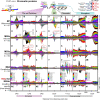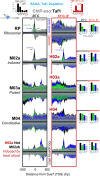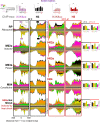An integrated SAGA and TFIID PIC assembly pathway selective for poised and induced promoters
- PMID: 36302553
- PMCID: PMC9732905
- DOI: 10.1101/gad.350026.122
An integrated SAGA and TFIID PIC assembly pathway selective for poised and induced promoters
Abstract
Genome-wide, little is understood about how proteins organize at inducible promoters before and after induction and to what extent inducible and constitutive architectures depend on cofactors. We report that sequence-specific transcription factors and their tethered cofactors (e.g., SAGA [Spt-Ada-Gcn5-acetyltransferase], Mediator, TUP, NuA4, SWI/SNF, and RPD3-L) are generally bound to promoters prior to induction ("poised"), rather than recruited upon induction, whereas induction recruits the preinitiation complex (PIC) to DNA. Through depletion and/or deletion experiments, we show that SAGA does not function at constitutive promoters, although a SAGA-independent Gcn5 acetylates +1 nucleosomes there. When inducible promoters are poised, SAGA catalyzes +1 nucleosome acetylation but not PIC assembly. When induced, SAGA catalyzes acetylation, deubiquitylation, and PIC assembly. Surprisingly, SAGA mediates induction by creating a PIC that allows TFIID (transcription factor II-D) to stably associate, rather than creating a completely TFIID-independent PIC, as generally thought. These findings suggest that inducible systems, where present, are integrated with constitutive systems.
Keywords: ChIP-seq; SAGA; Saccharomyces; gene regulation; genomics; transcription preinitiation complex.
© 2022 Mittal et al.; Published by Cold Spring Harbor Laboratory Press.
Figures







Similar articles
-
SAGA subunits Spt3 and Spt8 act directly and non-redundantly with TFIID in TBP recruitment in the Gcn4 transcriptome.Nucleic Acids Res. 2025 Jul 8;53(13):gkaf598. doi: 10.1093/nar/gkaf598. Nucleic Acids Res. 2025. PMID: 40637224 Free PMC article.
-
Dissection of coactivator requirement at RNR3 reveals unexpected contributions from TFIID and SAGA.J Biol Chem. 2008 Oct 10;283(41):27360-27368. doi: 10.1074/jbc.M803831200. Epub 2008 Aug 5. J Biol Chem. 2008. PMID: 18682387 Free PMC article.
-
SAGA-associated Sgf73p facilitates formation of the preinitiation complex assembly at the promoters either in a HAT-dependent or independent manner in vivo.Nucleic Acids Res. 2006;34(21):6225-32. doi: 10.1093/nar/gkl844. Epub 2006 Nov 7. Nucleic Acids Res. 2006. PMID: 17090597 Free PMC article.
-
Architecture of the multi-functional SAGA complex and the molecular mechanism of holding TBP.FEBS J. 2021 May;288(10):3135-3147. doi: 10.1111/febs.15563. Epub 2020 Sep 29. FEBS J. 2021. PMID: 32946670 Review.
-
SAGA and TFIID: Friends of TBP drifting apart.Biochim Biophys Acta Gene Regul Mech. 2021 Feb;1864(2):194604. doi: 10.1016/j.bbagrm.2020.194604. Epub 2020 Jul 14. Biochim Biophys Acta Gene Regul Mech. 2021. PMID: 32673655 Review.
Cited by
-
Histone acetylation readers Bdf1 and Yaf9 direct SWR1 remodeler to +1 nucleosome.Sci Adv. 2025 Aug 8;11(32):eadt2002. doi: 10.1126/sciadv.adt2002. Epub 2025 Aug 6. Sci Adv. 2025. PMID: 40768570 Free PMC article.
-
SAGA subunits Spt3 and Spt8 act directly and non-redundantly with TFIID in TBP recruitment in the Gcn4 transcriptome.Nucleic Acids Res. 2025 Jul 8;53(13):gkaf598. doi: 10.1093/nar/gkaf598. Nucleic Acids Res. 2025. PMID: 40637224 Free PMC article.
-
The minimal intrinsic stochasticity of constitutively expressed eukaryotic genes is sub-Poissonian.bioRxiv [Preprint]. 2023 Mar 8:2023.03.06.531283. doi: 10.1101/2023.03.06.531283. bioRxiv. 2023. Update in: Sci Adv. 2023 Aug 9;9(32):eadh5138. doi: 10.1126/sciadv.adh5138. PMID: 36945401 Free PMC article. Updated. Preprint.
-
A two-step regulatory mechanism dynamically controls histone H3 acetylation by SAGA complex at growth-related promoters.Nucleic Acids Res. 2025 Apr 10;53(7):gkaf276. doi: 10.1093/nar/gkaf276. Nucleic Acids Res. 2025. PMID: 40207626 Free PMC article.
-
Molecular basis of global promoter sensing and nucleosome capture by the SWR1 chromatin remodeler.Cell. 2024 Nov 27;187(24):6849-6864.e18. doi: 10.1016/j.cell.2024.09.007. Epub 2024 Oct 1. Cell. 2024. PMID: 39357520
References
Publication types
MeSH terms
Substances
Grants and funding
LinkOut - more resources
Full Text Sources
Molecular Biology Databases
Research Materials
